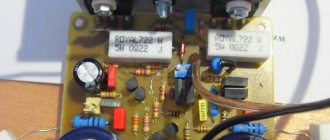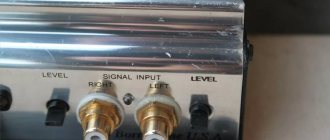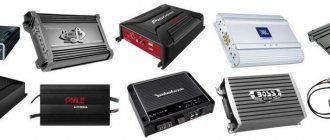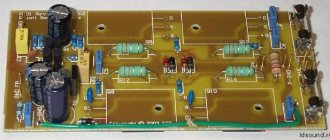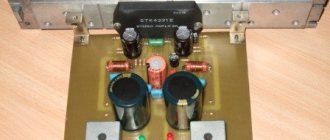Photo sent by Alexander (Allroy), Novorossiysk
By chance, I received a “modernized” power amplifier “Oda-UM102S”. The modernization was carried out by an unknown master so severely that only good “meaty” radiators remained alive. So I decided to adapt my new project to them, which smoothly flowed from the old one due to the desire to try out a new idea in hardware.
↑ “Green Lanzar” amplifier circuit and details
Correction: the power of R5 and R6 is sufficient 0.5 W. See comments.
If you look closely, this is a typical Lanzar, only its output is asymmetrical. But, since VT8+VT10 are a composite transistor according to the Darlington circuit, and VT9+VT11 are a Szyklai pair, we will count each of these pairs as one transistor. Therefore, the output of this amplifier seems asymmetrical only at first glance. Well, the amplifier works according to its prototype - efficiently and without hysterics.
Those same radiators from “Oda”
Since the required amplifier power was limited by radiators and 25AC-126 speakers, for which this project was conceived, the power supply was bipolar ±25 Volts. Nominal input voltage 0.8 Volts. At the same time, the output power of the amplifier is 25 watts at 4 ohms and there is some reserve for signal peaks up to 35 watts.
For those who like more power
, and I am also one of those, I can say that this circuit can be boosted up
to 200 Watts
by increasing the supply voltage, adding additional transistors to it and changing the values of some elements. But that's another story.
In this particular amplifier, I installed BUK657 MOSFETs at the output, but again, if you have other N-channel powerful field devices on hand, you can install them, as I wrote about earlier.
Fragment excluded. The full version is available to patrons and full members of the community.
I described how to make L1 on the Datagor forum, but if this option bothers anyone, then the coil can be wound on a 2-watt 10-33 Ohm resistor with a wire with a diameter of 0.8 mm in one layer.
VT5, VT6 are equipped with small radiators, which are an aluminum plate 10x20 mm.
REVIEW OF LANZAR POWER AMPLIFIERFrankly speaking, I was very surprised that the expression SOUND AMPLIFIER was gaining so much popularity. As far as my worldview allows me, only one object can act under the sound amplifier - a horn. It has really been amplifying sound for decades now. Moreover, the horn can amplify sound in both directions.
As can be seen from the photo, the horn has nothing in common with electronics, however, search queries for POWER AMPLIFIER are increasingly being replaced by SOUND AMPLIFIER, and the full name of this device, AUDITORY FREQUENCY POWER AMPLIFIER, is entered only 29 times a month versus 67,000 searches for SOUND AMPLIFIER. I’m just curious what this is connected with... But that was a prologue, and now the fairy tale itself:
The schematic diagram of the LANZAR power amplifier is shown in Figure 1. This is an almost standard symmetrical circuit, which has made it possible to seriously reduce nonlinear distortions to a very low level. This circuit has been known for quite a long time; back in the eighties, Bolotnikov and Ataev presented a similar circuit on a domestic element base in the book “Practical circuits for high-quality sound reproduction.” However, work with this circuitry did not begin with this amplifier. It all started with the PPI 4240 car amplifier circuit, which was successfully repeated:
Schematic diagram of the PPI 4240 car amplifier
Next was the article “Opening Amplifier -2” from Iron Shikhman (the article, unfortunately, was removed from the author’s website). It dealt with the circuitry of the Lanzar RK1200C car amplifier, where the same symmetrical circuitry was used as an amplifier. It is clear that it is better to see once than to hear a hundred times, so delving into my hundred-year-old recorded discs, I found the original article and present it as a quote:
OPENING THE AMPLIFIER - 2
A.I. Shikhatov 2002
A new approach to the design of amplifiers involves the creation of a line of devices using similar circuit solutions, common components and style. This allows, on the one hand, to reduce design and manufacturing costs, and on the other hand, it expands the choice of equipment when creating an audio system. The new line of Lanzar RACK amplifiers is designed in the spirit of rack-mounted studio equipment. The front panel, measuring 12.2 x 2.3 inches (310 x 60 mm), contains controls, and all connectors are located on the rear panel. This arrangement not only improves the appearance of the system, but also simplifies the work - cables do not get in the way. On the front panel you can mount the included mounting strips and carrying handles, then the device takes on a studio look. The ring illumination of the sensitivity control only enhances the similarity. The radiators are located on the side surface of the amplifier, which allows you to stack several devices in a rack without interfering with their cooling. This is an undoubted convenience when creating extensive audio systems. However, when installing in a closed rack, you need to worry about air circulation - install supply and exhaust fans, temperature sensors. In short, professional equipment requires a professional approach in everything. The line includes six two-channel and two four-channel amplifiers, differing only in output power and cabinet length.
| Frequency band | 15Hz-35kHz |
| Harmonic distortion | 0,04% |
| Sensitivity | 100mV-4V |
| Input impedance | 22 kOhm |
| Signal to noise ratio | >90 dB |
| Stereo separation | >60 dB |
| LPF cutoff frequency | 40-120 Hz |
| HPF cutoff frequency | 150Hz-1.5kHz |
| Bass booster | 0-18 dB |
The block diagram of the crossover of the Lanzar RK series amplifiers is shown in Figure 1. A detailed diagram is not given, since there is nothing original in it, and it is not this unit that determines the main characteristics of the amplifier. The same or similar structure is used in most modern mid-priced amplifiers. The set of functions and characteristics are optimized taking into account many factors: On the one hand, the crossover capabilities should allow the construction of standard audio system options (front plus subwoofer) without additional components. On the other hand, there is little point in introducing a full set of functions into a built-in crossover: This will significantly increase the cost, but in many cases it will remain unclaimed. It is more convenient to delegate complex tasks to external crossovers and equalizers, and to disable the built-in ones.
The design uses dual KIA4558S operational amplifiers. These are low-noise, low-distortion amplifiers designed with "audio" applications in mind. As a result, they are widely used in preamp stages and crossovers. The first stage is a linear amplifier with variable gain. It matches the output voltage of the signal source with the sensitivity of the power amplifier, since the gain of all other stages is equal to unity. The next stage is the bass boost control. In amplifiers of this series, it allows you to increase the signal level at a frequency of 50 Hz by 18 dB. In products from other companies, the rise is usually less (6-12 dB), and the tuning frequency can be in the region of 35-60 Hz. By the way, such a regulator requires a good power reserve of the amplifier: an increase in gain by 3 dB corresponds to doubling the power, by 6 dB to quadrupling, and so on. This is reminiscent of the legend about the inventor of chess, who asked the Raja for one grain for the first square of the board, and for each subsequent square - twice as many grains as for the previous one. The frivolous Raja could not fulfill his promise: there were no such quantity of grains on the whole Earth... We are in a more advantageous position: an increase in the level by 18 dB will increase the signal power “only” 64 times. In our case, 300 W are available, but not every amplifier can boast such a reserve. The signal can then be fed directly to a power amplifier, or the required frequency band can be selected using filters. The crossover part consists of two independent filters. The low-pass filter is tunable in the range of 40-120 Hz and is designed to work exclusively with a subwoofer. The tuning range of the high-pass filter is noticeably wider: from 150 Hz to 1.5 kHz. In this form, it can be used to work with a broadband front or for the MF-HF band in a system with channel amplification. The tuning limits, by the way, were chosen for a reason: in the range from 120 to 150 Hz there is a “hole” in which the acoustic resonance of the cabin can be hidden. It is also noteworthy that the bass booster is not turned off in any of the modes. Using this cascade simultaneously with a high-pass filter allows you to adjust the frequency response in the interior resonance region no worse than using an equalizer. The last cascade has a secret. Its task is to invert the signal in one of the channels. This will allow you to use the amplifier in a bridge connection without additional devices. Structurally, the crossover is made on a separate printed circuit board, which is connected to the amplifier board using a connector. This solution allows the entire line of amplifiers to use only two crossover options: two-channel and four-channel. The latter, by the way, is simply a “double” version of the two-channel one and its sections are completely independent. The main difference is the changed layout of the printed circuit board.
Amplifier
The Lanzar power amplifier is made according to a typical scheme for modern designs, shown in Figure 2. With minor variations, it can be found in most amplifiers of the middle and lower price category. The only difference is in the types of parts used, the number of output transistors and supply voltage. The diagram of the right channel of the amplifier is shown. The left channel circuit is exactly the same, only the part numbers start with a one instead of a two.
A filter R242-R243-C241 is installed at the amplifier input, eliminating radio frequency interference from the power supply. Capacitor C240 does not allow the DC component of the signal to enter the power amplifier input. These circuits do not affect the frequency response of the amplifier in the audio frequency range. To avoid clicks when turning on and off, the amplifier input is connected to a common wire with a transistor switch (this unit is discussed below, together with the power supply). Resistor R11A eliminates the possibility of self-excitation of the amplifier when the input is closed. The amplifier circuit is completely symmetrical from input to output. A double differential stage (Q201-Q204) at the input and a stage on transistors Q205, Q206 provide voltage amplification, the remaining stages provide current amplification. The cascade on transistor Q207 stabilizes the quiescent current of the amplifier. To eliminate its "unbalance" at high frequencies, it is bypassed with a mylar capacitor C253. The driver stage on transistors Q208, Q209, as befits a preliminary stage, operates in class A. A “floating” load is connected to its output - resistor R263, from which the signal is removed to excite the transistors of the output stage. The output stage uses two pairs of transistors, which made it possible to extract 300 W of rated power and up to 600 W of peak power. Resistors in the base and emitter circuits eliminate the consequences of technological variation in the characteristics of transistors. In addition, resistors in the emitter circuit serve as current sensors for the overload protection system. It is made on transistor Q230 and controls the current of each of the four transistors in the output stage. When the current through an individual transistor increases to 6 A or the current of the entire output stage to 20 A, the transistor opens, issuing a command to the blocking circuit of the supply voltage converter. The gain is set by the negative feedback circuit R280-R258-C250 and is equal to 16. Correction capacitors C251, C252, C280 ensure the stability of the amplifier covered by OOS. The circuit R249, C249 connected at the output compensates for the increase in load impedance at ultrasonic frequencies and also prevents self-excitation. In the audio circuits of the amplifier, only two electrolytic non-polar capacitors are used: C240 at the input and C250 in the OOS circuit. Due to their large capacity, it is extremely difficult to replace them with other types of capacitors.
Power supply The high-power power supply is made of field-effect transistors. A special feature of the power supply is the separate output stages of the converter for powering the power amplifiers of the left and right channels. This structure is typical for high-power amplifiers and makes it possible to reduce transient interference between channels. For each converter there is a separate LC filter in the power supply circuit (Figure 3). Diodes D501, D501A protect the amplifier from erroneous switching on in the wrong polarity.
Each converter uses three pairs of field-effect transistors and a transformer wound on a ferrite ring. The output voltage of the converters is rectified by diode assemblies D511, D512, D514, D515 and smoothed by filter capacitors with a capacity of 3300 μF. The output voltage of the converter is not stabilized, so the power of the amplifier depends on the voltage of the on-board network. From the negative voltage of the right and positive voltage of the left channel, parametric stabilizers generate voltages of +15 and -15 volts to power the crossover and differential stages of power amplifiers. The master oscillator uses the KIA494 (TL494) microcircuit. Transistors Q503, Q504 increase the output of the microcircuit and speed up the closing of the key transistors of the output stage. The supply voltage is supplied to the master oscillator constantly, the switching is controlled directly from the Remote circuit of the signal source. This solution simplifies the design, but when turned off, the amplifier consumes insignificant quiescent current (several milliamps). The protection device is made on a KIA358S chip containing two comparators. The supply voltage is supplied to it directly from the Remote circuit of the signal source. Resistors R518-R519-R520 and a temperature sensor form a bridge, the signal from which is fed to one of the comparators. A signal from the overload sensor is supplied to another comparator through a driver on transistor Q501. When the amplifier overheats, a high voltage level appears at pin 2 of the microcircuit, and the same level appears at pin 8 when the amplifier is overloaded. In any emergency case, signals from the output of the comparators through the OR diode circuit (D505, D506, R603) block the operation of the master oscillator at pin 16. Operation is restored after eliminating the causes of the overload or cooling the amplifier below the temperature sensor response threshold. The overload indicator is designed in an original way: the LED is connected between the +15 V voltage source and the on-board network voltage. During normal operation, voltage is applied to the LED in reverse polarity and it does not light. When the converter is blocked, the +15 V voltage disappears, the overload indicator LED turns on between the on-board voltage source and the common wire in the forward direction and begins to glow. Transistors Q504, Q93, Q94 are used to block the input of the power amplifier during transient processes when turning on and off. When the amplifier is turned on, capacitor C514 is slowly charged, transistor Q504 is in the open state at this time. The signal from the collector of this transistor opens the keys Q94,Q95. After charging the capacitor, transistor Q504 closes, and the -15 V voltage from the output of the power supply reliably blocks the keys. When the amplifier is turned off, transistor Q504 instantly opens through diode D509, the capacitor quickly discharges and the process is repeated in the reverse order.
Design
The amplifier is mounted on two printed circuit boards. On one of them there is an amplifier and a voltage converter, on the other there are crossover elements and turn-on and overload indicators (not shown in the diagrams). The boards are made of high-quality fiberglass with a protective coating for the tracks and are mounted in a housing made of an aluminum U-shaped profile. Powerful transistors of the amplifier and power supply are pressed with pads to the side shelves of the case. Profiled radiators are attached to the outside of the sides. The front and rear panels of the amplifier are made of anodized aluminum profile. The entire structure is secured with self-tapping screws with hexagon heads. That's all, actually - the rest can be seen in the photographs.
As you can see from the article, the original LANZAR amplifier itself is not bad at all, but I wanted something better... I searched the forums, of course on Vegalab, but didn’t find much support - only one person responded. Perhaps it’s for the better - there aren’t a ton of co-authors. Well, in general, this particular appeal can be considered Lanzar’s birthday - at the time of writing the comment, the board was already etched and soldered almost completely.
So Lanzar is already ten years old... After several months of experiments, the first version of this amplifier, called “LANZAR”, was born, although of course it would be fairer to call it “PIPIAI” - it all started with him. However, the word LANZAR sounds much more pleasant to the ear. If someone SUDDENLY considers the name an attempt to play on a brand name, then I dare to assure him that there was nothing like that in mind and the amplifier could have received absolutely any name. However, it became LANAZR in honor of the LANZAR company, since this particular automotive equipment is included in that small list of those who are personally respected by the team that worked on fine-tuning this amplifier. A wide range of supply voltages makes it possible to build an amplifier with a power from 50 to 350 W, and at powers up to 300 W for UMZCH coffee. nonlinear distortion does not exceed 0.08% throughout the entire audio range, which allows the amplifier to be classified as Hi-Fi. The figure shows the appearance of the amplifier. The amplifier circuit is completely symmetrical from input to output. A double differential stage (VT1-VT4) at the input and a stage on transistors VT5, VT6 provide voltage amplification, the remaining stages provide current amplification. The cascade on transistor VT7 stabilizes the quiescent current of the amplifier. To eliminate its “asymmetry” at high frequencies, it is bypassed with capacitor C12. The driver stage on transistors VT8, VT9, as befits a preliminary stage, operates in class A. A “floating” load is connected to its output - resistor R21, from which the signal is removed to excite the transistors of the output stage. The output stage uses two pairs of transistors, which made it possible to extract up to 300 W of rated power from it. Resistors in the base and emitter circuits eliminate the consequences of technological variation in the characteristics of transistors, which made it possible to abandon the selection of transistors by parameters. We remind you that when using transistors from the same batch, the spread in parameters between transistors does not exceed 2% - this is the manufacturer’s data. In reality, it is extremely rare that parameters go beyond the three percent zone. The amplifier uses only “one-party” terminal transistors, which, together with balance resistors, made it possible to maximally align the operating modes of the transistors with each other. However, if the amplifier is being made for a loved one, then it will not be useless to assemble the test stand given at the end of THIS ARTICLE. Regarding the circuitry, it only remains to add that such a circuitry solution provides one more advantage - complete symmetry eliminates transient processes in the final stage (!), i.e. at the moment of switching on, there are no surges at the output of the amplifier, which are characteristic of most discrete amplifiers.
Figure 1 - schematic diagram of the LANZAR amplifier. .
Figure 2 - appearance of the LANZAR V1 amplifier.
Figure 3 - appearance of the LANZAR MINI amplifier
Schematic diagram of a powerful stage power amplifier 200 W 300 W 400 W UMZCH on high quality transistors Hi-Fi UMZCH
Power amplifier specifications:
| PARAMETER | PER LOAD | ||||||||||||||||||||||||||||||||||||||||||||||||
| 8 ohm | 4 Ohm | 2 Ohm (4 Ohm bridge) | |||||||||||||||||||||||||||||||||||||||||||||||
| Maximum supply voltage, ± V | ±65 V | ±60 V | ±40 V | ||||||||||||||||||||||||||||||||||||||||||||||
| Maximum output power, W at distortion up to 1% and supply voltage: | |||||||||||||||||||||||||||||||||||||||||||||||||
| ±30 V | 40 | 85 | 170 | ||||||||||||||||||||||||||||||||||||||||||||||
| ±35 V | 60 | 120 | 240 | ||||||||||||||||||||||||||||||||||||||||||||||
| ±40 V | 80 | 160 | 320 | ||||||||||||||||||||||||||||||||||||||||||||||
| ±45 V | 105 | 210 | |||||||||||||||||||||||||||||||||||||||||||||||
| ±50 V | 135 | 270 |
| ||||||||||||||||||||||||||||||||||||||||||||||
↑ Files
The archive contains a drawing of the amplifier's printed circuit board.


